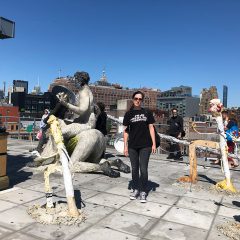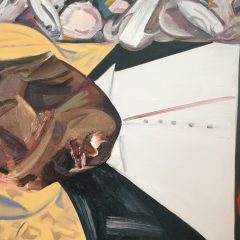Last Thursday we saw two excellent exhibits. It may be summer in New York but the art is still fine. Here’s our review of After Nature at the New Museum. Look for a post on MoMA’s Home Delivery exhibit soon.
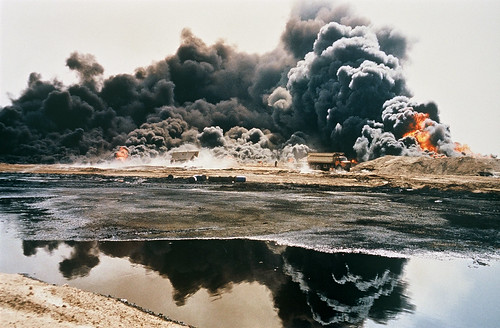
Werner Herzog (b. 1942)
And A Smoke Arose—Lessons of Darkness
1992
16mm film transferred to DVD, sound, color, 5 min
Courtesy Werner Herzog Film GmbH, Munich
With this exhibit the New Museum has shown that they’re going to march to their own drumbeat and we’re ready to listen here on artblog. It’s a particularly European show with lots of male frontal nudity and a matter-of-fact acceptance of flesh that you don’t see in American art shows. We’re such Puritans here–sex obsessed and yet embarrassed by ourselves!
The entire show is about acceptance–acceptance of ourselves as part of the earth; acceptance of the decay and degradation of the earth; acceptance of the non-normal as normal. It’s a mournful show with a lot of beauty–but also mud.
Here are some of the highlights for us:
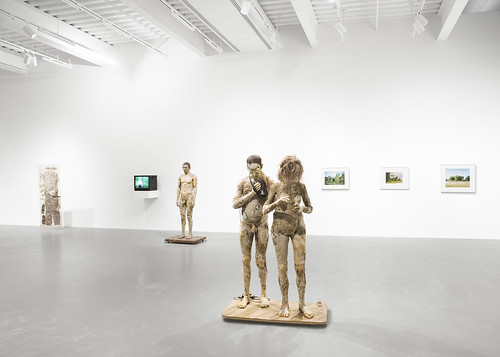
Pawel Althamer (b. 1967)
Pawel and Monika
2002
Straw, hemp fiber, animal intestine, wax and hair
70 x 43 3/4 x 29 1/2 in (178 x 111 x 75 cm)
Collection of Tony and Daniel Holtz
Photo by Benoit Pailley
Pawel Althamer is the keynote of the show. He gets a room pretty much to himself and he deserves it. His work is all self-portraiture from Pawel as a fetus to Pawel as a tourist to Pawel as a decay site. It’s Pawel as everyman (and woman). He’s a little bit of a schmuck, a dork, and not a superman. At a time when summer blockbusters and the Olympics have us all thinking of bionic humans and heroes, Pawel’s created something modest and yet powerful for being so.
And his materials are biological materials (animal hides and intestines, hay…) things that are going to fall apart and in many cases here have already begun to do so.
Stephan Balkenhol is a point of comparison but so are the paintings of Breughel with their emphasis on human foibles. He’s the anti Matthew Barney — no fabulism and no hermetic sterility. You can get this work and identify with it.
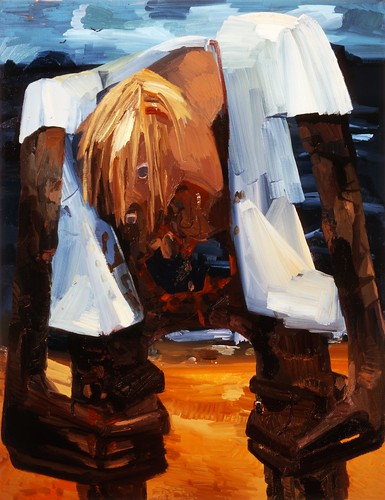
Dana Schutz’s Man Eating his Chest comes right out of the Medieval chamber of horrors. But the painting couldn’t have been more contemporary in its approach–falling into abstraction when you least expect it. Her works have the heaviness of Alice Neel’s grounded figures and the brutal brush strokes and anti-militarist nature of Georg Baselitz. Goya’s Saturn Eating his Children is also pertinent. This is a picture of the world eating itself. Modest in size the piece packs a wallop.

Roger Ballen (b. 1950)
Untitled (1069), 2007
Selenium-toned gelatin silver print
19 3/4 x 19 3/4 in (50 x 50 cm)
Courtesy Gagosian Gallery, New York
Roger Ballen’s low-contrast black and white photos are harrowing. They depict people in prison-like settings mostly photographed against walls scratched with pale markings, throwing you right into the cell-like space to feel the damp floor, the cruddy lighting and the uncomfortableness of the space. You know the photos are setups and their anonymity makes them feel like any war zone. The markings on the walls are not beautiful like Lascaux cave markings but they evince the sense that there is a need to mark and to survive. We thought about the Abu Ghraib photos when we saw them.
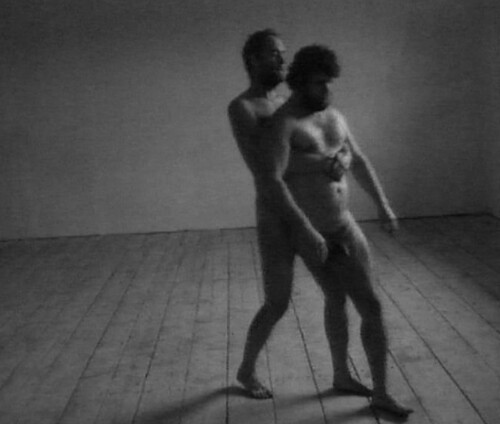
Artur Zmijewski (b. 1966)
Oko za Oko (An Eye for an Eye)
1998
Digital video, black-and-white and color, sound, 10 min
Courtesy Foksal Gallery Foundation, Warsaw
Some of the works in the show are quite old, like Artur Zmijewski’s video Oko za Oko (An Eye for an Eye) from 1998. But it is one of the highlights. The 10-minute video held us for 10 minutes with nowhere to sit (a recurring issue throughout the show–no seating for many of the great videos). The affect is one of war and its aftermath. In an institutional setting two amputees are helped to perform daily functions like showering and getting up and down stairs by aides who are not disabled. The relationship between the aide and amputee is completely loving and symbiotic and deep as if the aide is trying to make the amputee whole again. All the scenes are filmed with all participants naked and the whole thing is stunningly beautiful even as we are forced to look at the amputated limbs up close and in detail. This is a movie that could not have been made in this country where we are in denial and don’t want to confront the hard truths of life.
The performance piece we saw by Tino Sehgal — one of several he choreographed for the show — was riveting. (Sorry we don’t have a photo of this piece. The artist wouldn’t allow photos to be taken.) A beautiful young woman dressed in casual street clothes writhes like a worm on the floor. At one point she looks up at you with her hands sighting an invisible camera as if she’s taking your picture. It’s an accusation to all voyeurs everywhere who don’t take action.
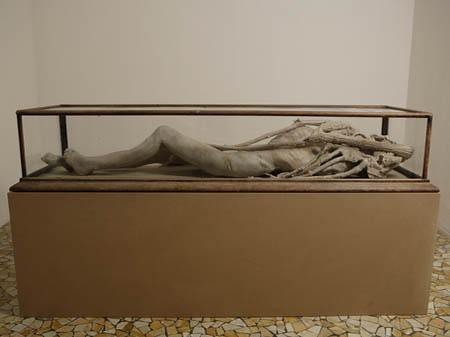
Berlinde De Bruyckere, Robin V, 2006–07. Painted wax and resin, glass, and wood, 44 1/8 x 28 3/4 x 96 1/2 in (112 x 73 x 245 cm). Museum of Art Lucerne. Image courtesy Galleria Continua, San Gimignano and Beijing. Photo by Mirjam Devriendt
Berlinde De Bruyckere’s sarcophagus holding a repelling wax ur-figure, something not quite human, has some allegiance with Seghal’s writhing performer. The figure has a weird-science affect, like a specimen from Star Trek or Alien captured under glass in a natural science museum. This isn’t a very likeable piece but it held our interest and fit with the show completely. This work, like a lot of work here seems to have to do with roots and earth and the subterranean. This artist’s sense of physicality was a big part of her horse and people pieces in 2005’s group show Springtide at ICA.
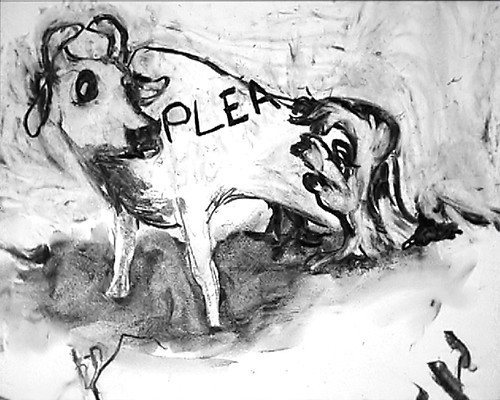
Nathalie Djurberg (b. 1978)
My Name Is Mud
2003
Charcoal animation and digital video
5:54 min
Courtesy Zach Feuer Gallery, New York, and Gió Marconi,
Milan
Nathalie Djurberg’s charcoal animation My Name is Mud is as pleasing as De Bruyckere’s piece is off-putting. Even as earth and vegetation swallows up people, animals and trees, there’s a jauntiness to it (The cow says “No I’m too young to die!”). The animistic mud grows like kudzu and swallows everything in its path. Djurberg’s technique is similar to William Kentridge’s and there’s a darkness and agitation that comes through from the repeat erasure marks and pentimenti from past drawings that no longer exist. Djurberg, by the way, who seems obsessed with breasts leaking milk — we confess this is based on our viewing only two videos — was in the Puppet Show at the ICA last year.
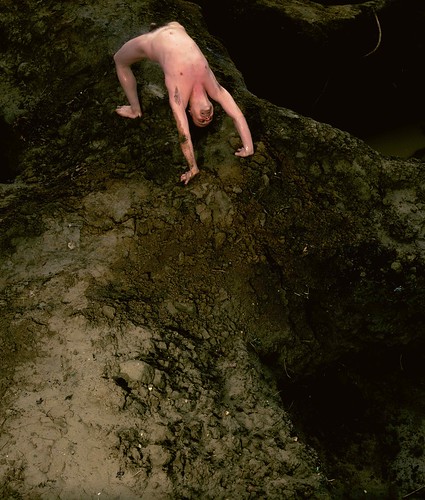
Diego Perrone (b. 1970)
I Pensatori di Buchi
2002
Lambda print
49 ” x 59 in (126 x 150 cm)
Courtesy of the artist, Casey Kaplan, New York, and
Massimo De Carlo, Milan
Speaking of mud and subterranean, the hole man Diego Perrone dug and burned huge holes in the earth with his father helping. Then he conscripted local men to get naked and interact with the earth and holes. Then he took pictures, and the series I Pensatori di Buchi (The Thinkers of Holes) shows the clash of earth and skin as primal — and somehow comic. The holes are gargantuan and the men are little pink sprites doing gymnastics.
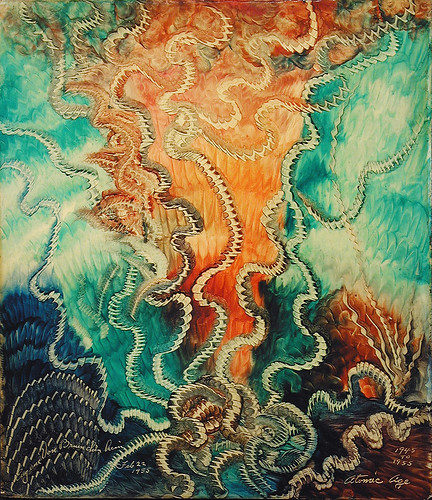
Eugene Von Bruenchenhein (1910–1983)
Atomic Age
1955
Oil paint on board
17 x 15 in (43 x 38 cm)
Courtesy Kinz, Tillou + Feigen, New York
Amidst all the dirt and weird spirituality, it’s fitting to have included Howard Finster, Eugene Von Brunchenheim and that visionary filmmaker Werner Herzog (see photo at the top). Finster is represented with his sometimes earthy notes from his sermons (we especially liked the sex sermon which cautions against 3x a day but gives newlyweds the green light for 2x a day!). Von Brunchenheim has some wonderful post-apocalyptic finger paintings and a gilded chicken and turkey bone tower. And Herzog finds a real world apocalypse in his surveillance video, Lessons of Darkness, whose flyover footage of the 1991-92 oil fields burning in Kuwait is spectacular and spectacularly upsetting.
The Cultural Gap too Big to Bridge Award goes to Fikret Atay. His 6-minute video Any Time Prime Time, which we stood through twice, captivated, repelled and confused. Why are all these men behaving as sheep while a drummer beats and a shepherd beats them?
Cultural divide notwithstanding all the work feels relevant and gives us a different take on a world going to hell in a handbasket. It’s a humanist show with very little whizbang gizmo-ism in it.
Here’s who else is in the show, organized by Massimiliano Gioni, Director of Special Exhibitions. ( The show spans three floors and includes over 90 works).:
Allora and Calzadilla, Micol Assaël, Huma Bhabha, Maurizio Cattelan, William Christenberry, Roberto Cuoghi, Bill Daniel, Nancy Graves, Robert Kusmirowski, Zoe Leonard, Klara Liden, Erik van Lieshout, Thomas Schütte and August Strindberg.
We were inspired to see the show by Peter Schjeldahl’s review in the New Yorker. We loved the show better than he did but he had lots of interesting things to say, some of which we too have been saying for a long time, such as, that humans are fouling their nest and they need to be in touch with their earth and their relationship to it. The show’s up to Sept. 21.


